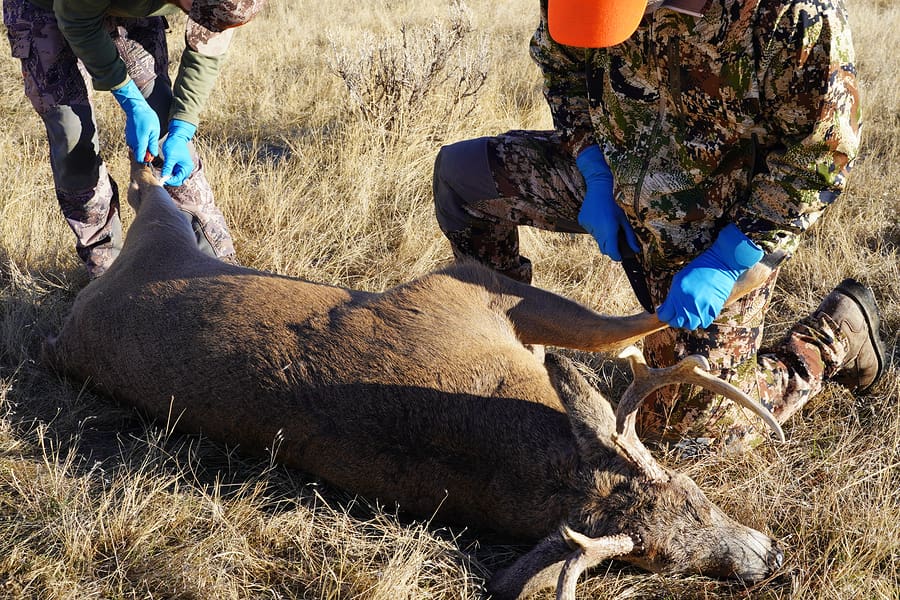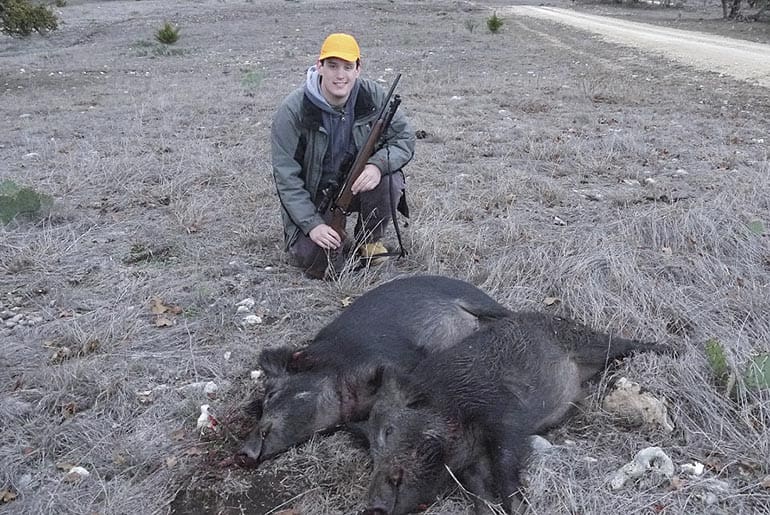Deer, pigs, elk and other game animals can carry brucellosis. Know how to protect yourself this fall.
Hunting feral hogs is big business here in Texas and other states. The critters are widespread throughout the southeast and west coast. And they’re spreading.
A hog hunt, one in which you bag a single pig, can run you upwards of $500 (not including food, ammo, rifle…). The good news is that in Texas and many other states, hogs are considered invasive non-game animals that can be hunted year-round with no bag limit.
They’re enough of a problem in these parts that to help in the ongoing anti-swine efforts, you don’t even need a license to hunt them here in Texas any more.

Feral hogs are terrible, destructive animals that cause hundreds of millions of dollars of damage every year. So hunters reducing the population of these delicious creatures benefits everyone.
But according to the Centers for Disease Control and Prevention, feral hogs — like other free-ranging wild critters — can pose a risk to hunters above and beyond the regular traumatic variety.
Wild hogs can carry brucellosis, a nasty bacterial infection. From the CDC . . .
People can get the disease when they are in contact with infected animals or animal products contaminated with the bacteria.
If you are a hunter of particular wild animals, you may face an increased risk of brucellosis. This is because hunters are often exposed to the blood and organs of the animals they are hunting.
For those who slept through microbiology, brucella bacteria, which causes brucellosis, is a gram negative disease of the nervous system. That means traditional antibiotics are less effective against the disease.
Again from the CDC . . .
Signs and symptoms of brucellosis can include fever, chills, sweating, headache, low appetite, fatigue, and joint or muscle pain.
It may take anywhere from a week up to a month after coming into contact with the infected animal for you to start feeling sick. See a doctor right away if you experience these signs and symptoms. Be sure to tell your doctor about your contact with wild animals, especially wild hogs, deer, moose, elk, and bison. Your doctor can test your blood for brucellosis.
If you contract it, the symptoms can persist throughout your life. It can be treated with a lengthy course of modern antibiotics like Gentamicin, but it’s a bacterial disease that’s no fun at all while you have it.
While pigs are particularly nasty and some of the most frequent carriers, they aren’t the only critters that pose a brucellosis transmission risk. Besides feral swine, these game animals can carry it, too:
-
- elk
- bison
- caribou
- moose
- deer
That’s right, even Bambi can infect you. But there are some basic safety tips you can use to avoid exposure.
How to Reduce the Risk of Brucellosis Exposure
According to the CDC, the risk of infection is highest when coming into direct contact with the blood and organs of wild animals. Transmission appears to be most prevalent during a blood-to-blood contact (handling bloody parts with an open cut), but anywhere wet on your body (eyes, mouth) can be a prime location for transmission.
With fall hunting season (finally!) approaching, how can hunters protect themselves from the bacterial threat?
Say it with me: body substance isolation. You need to avoid contact with blood, urine, feces and other bodily fluids when you’re out in the field.

This video we filmed a few years ago shows good field dressing body substance isolation practices. Note that while gutting this deer, Tyler was wearing both latex gloves and eye protection.
Field Dressing Safety Tips
Here are some safety tips you should follow to avoid brucellosis exposure when hunting this fall:
- Use clean, sharp knives for field dressing and butchering.
- Wear eye protection and rubber or latex gloves (disposable or reusable) when handling carcasses.
- Avoid direct (bare skin) contact with fluid or organs from the animal.
- Avoid direct (bare skin) contact with hunting dogs that may have come into contact with hunted animals.
- After butchering, burn or bury disposable gloves and parts of the carcass that will not be eaten.
- Don’t feed dogs with raw meat or other parts of the carcass.
- Wash hands as soon as possible with soap and warm water for 20 seconds or more. Dry hands with a clean cloth.
- Clean all tools and reusable gloves with a disinfectant, like diluted bleach. (Follow the safety instructions on the product label).
- Thoroughly cook meat from any animal that is known to be a possible carrier of brucellosis (see the list above).
- Be aware that freezing, smoking, drying and pickling do not kill the bacteria that cause brucellosis.
Remember, when you take that 400-pound hog or 14-point buck this fall, keep basic body substance isolation practices in mind. It’s really pretty easy. Before you start to field dress or butcher, grab the latex or rubber gloves first. And keep your eye protection on.





all mammals carry disease.
even steinschwalben.
More vile are the hateful swine that attack good people for no reason here in TTAG… 😉
I agree…Gun Talking Swine who get off on the idea of beating women and children are at the top of the list…Ring a bell?
does the name quasimodo ring a bell?
Sing along jr…A hunting we will go…https://youtube.com/watch?v=-kLvnE0SeOE&feature=shared
“…of beating women and children are at the top of the list…”
It’s good to see you agree you’re vile swine.
Since you’re neither a woman or a child, you’re good-to-go? 😉
I liked hunting/trapping wild pigs. I especially like eating them. I despise cleaning them. Many years ago me and my buddies would camp in the river swamp. It was the spit of land between the Ochlocknee River and the mouth of Telogia Creek. We called it The Forks. Anyway, there would be half a dozen of us at any time. The population in camp fluctuated. It was one person’s duty to kill a hog every couple of days for camp meat. It wasn’t hard to do.This duty could vary depending if someone drug a deer to camp, had a good morning on a duck slue, or even a mess of squirrels. Of course, we were on the river and squirrel liver makes good bush hook bait for catfish. Not saying it’s smart, but the only time I’ve put on a rubber glove in my life was at a crime scene.
I think I’d want to wear double or triple rubber gloves if I ever touched a particular person… 🙂
Fall Hunting Safety Tip.
Choose your hunting partner wisely.
*Rrrrrring*
911, what’s your emergency?
“My friend fell out of his tree stand, I think he’s dead?”
Well first make sure he is dead.
“Uhhh, okay. click click,*Kaboomb* Uh he’s dead alright, now what?”
Why would you be so stupid as to wait until deer season to shoot a hog and scare off the deer? but I guess that goes with me guys I see every September and October getting out a high-dollar 300 Win Mag bolt-action rifle with several thousand dollars of scope and zeroing it and being unable to maintain a better than 3-in group at 100 yards….
Whenever I shoot a gunm during deer season I always play AC/DC
Then the deer wonder if it was gunm fire or Thunder
Been using Nitrile gloves for butchering meat for years. Habit from being forced to wear gloves in the kitchens I used to work in. Most states require latex or vinyl gloves for food service.
Only problem I have is getting the gloves large enough. Even the xl latex gloves split either when I’m putting them on or shortly afterwords. xxl are harder to find and usually out of stock with most food service vendors. Went to nitrile and usually can get them in xxl. Always had these big thick hands.
This is a growing problem and really is something that most people regard as part of the ‘hunting’ world in general. Those that don’t hunt will never have any reason to get involved. Such thinking is a mistake when it comes to this. Wild hogs are a pestilence to be eradicated. This situation is an example for the need to have an AR10.
Deer at a tad bit more discerning about what they consume. Wild hogs will eat anything. As long as I’m not living in a post apocalyptic world filled with zombies and total economic collapse, I see no reason to subject myself to wild pig for dinner.
I fully expect this to be a much more prevalent issue in urban residential areas as time goes on with so many new neighborhood developments are being built and spreading out. Texas might not require permits to shoot them but that wont change the laws and ordinances regarding shooting firearms in the city, county, and high occupancy locations. I can see where someone shoots a pig and just doing that creates a firefight with gangs and drug dealers.
“Wild hogs are a pestilence to be eradicated.”
Disagree. Feral hogs have been in Florida since the 1500s. They can be controlled, if people are not too lazy or proud.
Trap them and feed them corn, if you are picky.
Restated – feral hogs are a first world problem…
The world does not revolve around Florida.
If it stopped right there then this article would center around that state and Texas never would have needed to rewrite law to remove permitting. If it stopped right there then property owners across the country would not be seeing so much destruction and paying people to shoot them. You can certainly feed them, herd them, and raise them like family pets. You can also breed them under controlled conditions for food. But doing all that is part of how this all got started in the first place.
People pay landowners to hunt hogs. Not vice versa.
FL has been unlimited gun/light/trap 24/7 on private lands for a long time. Before Texas woke up.
Feral hogs are the personal property of whoever owns the land they are standing on, in Florida.
The hog panic is driven by antigun, antihunter, antiredneck people who want no hogs, no meateaters, AND no hunters. MSM is as always happy to oblige.
Sorry to see you are apparently a victim.
Comments are closed.